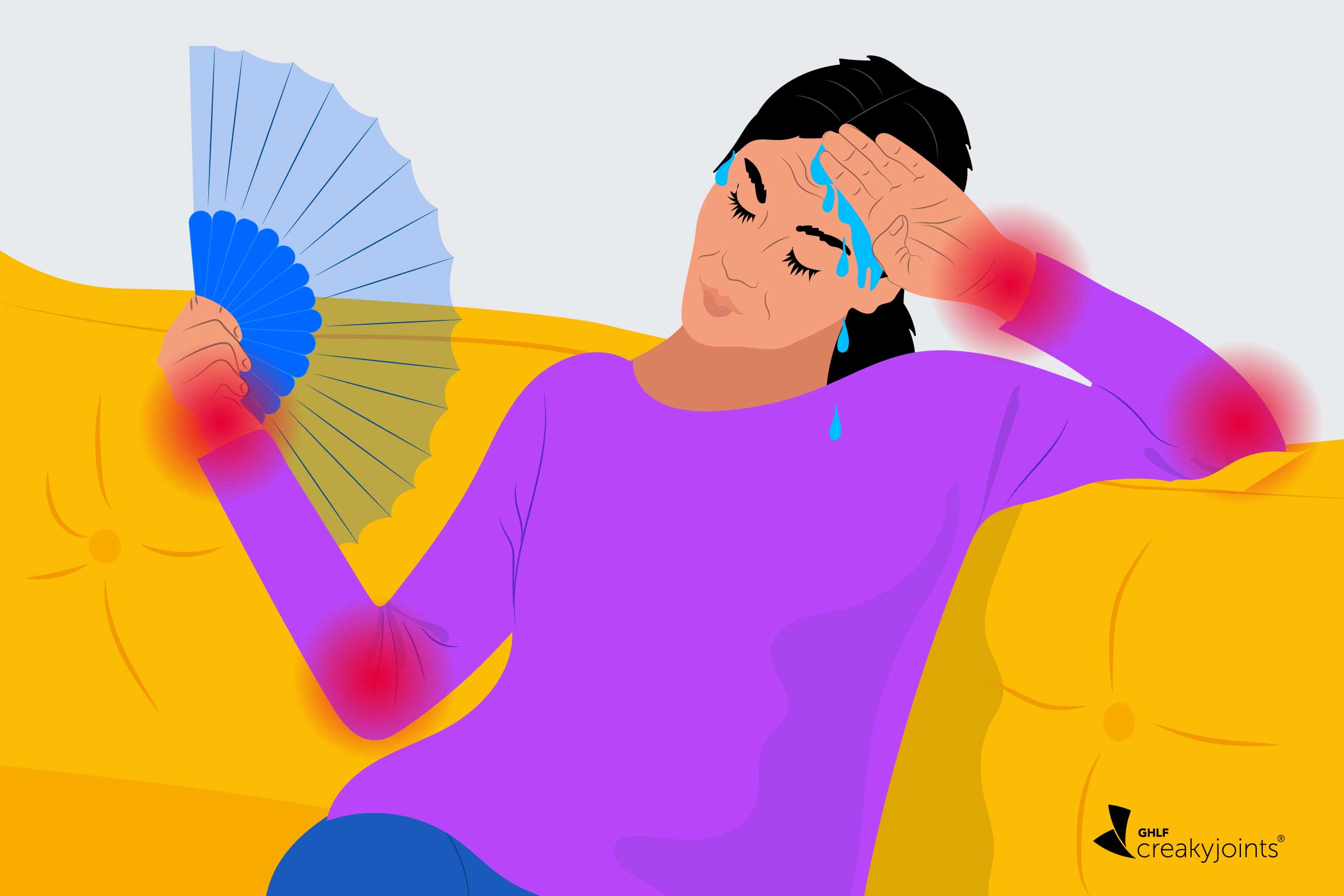Every year, top researchers, doctors, and other experts gather together at the world’s largest medical meeting for rheumatology professionals: the American College of Rheumatology/Association of Rheumatology Health Professionals Annual Meeting, held in 2019 in Atlanta.
The point of the meeting is for doctors to learn the latest thinking in how to prevent, diagnose, treat, and care for patients with all kinds of arthritis and rheumatologic conditions, and for researchers to share their latest discoveries, including updates on new medications to more effectively treat these diseases.
Of course, the patient perspective at such meetings matters and is growing in importance, as more and more research factors in patient-reported outcomes, or PROs. We at CreakyJoints do our best to learn as much as possible at conferences like ACR so we report back key updates for our patient community back home. The CreakyJoints team was on site at ACR, reviewing studies, attending sessions from top experts, and chatting with patients and physicians for their take on the most important findings and trends.
A Need for More Focus on Hispanic Patients
One area we paid especially close attention to this year at ACR was research among Hispanic patient populations.
Although the Hispanic population is the largest minority in the United States, comprising nearly 60 million Americans, there are very limited disease-specific resources — and a large need for it.
According to Pew Hispanic research, 71 percent of Hispanics obtain health information through their social networks and 79 percent of them act on this information. But the general health information available for the Hispanic community online heavily leans towards dangerous misinformation, which has led to low levels of diagnosis and a growing knowledge gap, as well as a community that spends the least on health care, according to the U.S. Bureau of Labor Statistics, and has decreased participation in open enrollment, according to data from the Centers for Medicare & Medicaid Services.
We are proud of our efforts to help reduce this disparity through CreakyJoints Español, our Hispanic-focused website, social media, and external outreach initiative.
Although there is much more work to do, we are happy to see that some rheumatology professionals are focused on changing this. We need more research (clinical trials, observational studies, and those involving patient-reported outcomes) conducted among the Hispanic patient community. If we increase participation of Hispanic patients in rheumatology research, we will better understand how to effectively treat different patient communities and, in turn, improve our ability to provide personalized and precision medicine for all individuals.
Below you can read about some of the key studies shared at this ACR meeting that focused on Hispanic patient communities.
For more research breakthrough from ACR 2019, check out our main guide: 50+ Arthritis Updates That Should Be on Your Radar.
For more specific research on the following conditions, check out our ACR coverage on:
- Rheumatoid Arthritis (RA) Updates
- Axial Spondyloarthritis (axSpA) Updates
- Psoriatic Arthritis (PsA) Updates
- Osteoarthritis (OA) Updates
- Gout Updates
1. Hispanic RA patients may report feeling worse than their doctors observe — and fibromyalgia may be a factor
When RA patients get regular check-ups at the rheumatologist, doctors assess how they’re doing in a number of different ways, such as blood tests, counting tender/swollen joints, and looking at imaging such as X-rays. Doctors also do what’s called a “physician global assessment,” which is a score of how they think patients are doing based on a number of different factors and patients do a self-report of how they’re doing, based on various surveys you complete about how you feel in various aspects of your life and disease management. Researchers from Rush University Medical Center in Chicago presented data at the ACR 2019 meeting that showed that Hispanic patients with rheumatoid arthritis often report they are doing worse than their doctors perceive them to be — a worse discrepancy than with non-Hispanic White patients or Black patients with RA. The researchers noted that these kinds of discrepancies were more common in patients who also met criteria for having fibromyalgia.
If you feel like your pain, fatigue, ability to do everyday tasks is poor and not improving, despite being on medication for RA, make sure to bring this up with your doctor and discuss what you can do as a team to help you feel better. If you suspect you might have symptoms of fibromyalgia but have not discussed this with your doctor, ask about this too. You might need separate medication or lifestyle changes to manage symptoms that are unique to fibromyalgia.
2. It’s important to ask your rheumatologist about your cardiovascular risk
When it comes to cardiovascular risk in people inflammatory forms of arthritis, Hispanic patients may face a double disadvantage. For one thing, evidence suggests that the tools that doctors use to calculate heart disease risk might underestimate the risk of anyone living with chronic inflammatory conditions such as rheumatoid arthritis, psoriatic arthritis, or lupus, because they don’t factor in systemic inflammation that we now know can have a significant impact on heart disease risk. For another, the “Hispanic population has been underrepresented in [cardiovascular] risk assessment research,” according to researchers from Westchester Medical Center in Valhalla, New York.
They studied a group of patients over age 40 who did not have an established heart disease diagnosis and were not currently on cholesterol-lowering medication and calculated their heart disease risk using the Atherosclerotic Cardiovascular Disease (ASCVD) calculator. In group of 53 patients that was 85 percent Hispanic, they found that 13 percent of patients met the criteria for starting cholesterol-lowering statin drugs based on their calculated scores.
“Although we have a small sample size,” the researchers noted, “this study demonstrates the ease and feasibility of performing [cardiovascular risk assessment in clinical practice.”
3. A formula that predicts the risk of high blood pressure can help Hispanic rheumatology patients
The PROOF-BP calculator is a special formula, or algorithm, which helps predict risk of developing hypertension, or chronic high blood pressure. Researchers from a Mexican hospital shared data that demonstrated this calculator can be used to help lower the number of Hispanic patients who are living with untreated hypertension. When they used the calculator in a group of 217 rheumatology patients (the most frequent diagnosis was rheumatoid arthritis, with 36 percent of patients), they found that 39 percent of people were initially classified as having either a medium to high risk of hypertension, but only 43 percent of patients that required additional evaluation followed the recommendation. More research may be needed to make sure patients understand what hypertension is and how it can affect heart disease risk in people with rheumatic conditions, and how to encourage people at risk of hypertension to get regular follow-up and treatment if necessary.
4. How early does ‘early treatment’ of rheumatoid arthritis need to be? A Puerto Rico study sheds some new light.
Doctors now know that early and aggressive treatment of rheumatoid arthritis with disease-modifying drugs (DMARDs) is associated with better outcomes, but questions remain over the ideal early window. This is especially important when you consider how in many parts of America, it can take weeks or months to get an appointment at a rheumatologist once you’re referred from your primary care doctor. Previous research has established that people who are diagnosed and start treatment within six months fare better than those who are treated after six months, but is a shorter window — less than three months — even better?
A new analysis of a group of Puerto Rican patients found that the answer was no. Researchers could not detect an improvement in patients’ outcomes based on whether they started DMARD medication with three months of being diagnosed versus between three and six months. It’s not the final word, of course, and other factors need to be considered, such as how long patients have symptoms present before getting diagnosed, how aggressive the course of disease is, etc. But it does seem to indicate that “the therapeutic window of less than six months seems reasonable for this group of patients,” the authors note.
5. Hispanic patients with rheumatoid arthritis take three to four times as long to see a rheumatologist as other patient groups*
Rush University researchers analyzed data on 152 patients who were first diagnosed with rheumatoid arthritis at their clinic between 2011 and 2016: 35 percent were White, 37 percent were Black, 20 percent were Hispanic, and 8 percent fell into an “other” category. They found that there was a median delay to a first rheumatology visit of six to eight months for all patient groups, except for Hispanic patients — who experienced a delay of 22.7 months. Interestingly, native language did not appear to play a role in the delay, as there was no difference between those who selected Spanish as their preferred language and those who selected English. What may make a difference is whether or not patients regularly see a primary care doctor: A higher percentage of White and Black patients were referred to the rheumatology clinic by primary care physicians relative to Hispanic patients, who mainly referred themselves.
The researchers concluded that all RA patients, but especially Hispanic patients with the longest delays, “are at risk of poorer outcomes as a consequence of delayed presentation to a rheumatologist leading to delay in treatment initiation.” We need more research to understand what factors lead to this delay and how to shorten the time to diagnosis, especially for Hispanic patients.
*Note: This study was presented at the 2018 ACR meeting, but we felt the findings were so important that we needed to include them here.
You Can Participate in Arthritis Research Too
If you are diagnosed with arthritis or another musculoskeletal condition, we encourage you to participate in future studies by joining CreakyJoints’ patient research registry, ArthritisPower. ArthritisPower is the first-ever patient-led, patient-centered research registry for joint, bone, and inflammatory skin conditions. Learn more and sign up here.
2019 Marketplace Open Enrollment Period Public Use Files. Centers for Medicare & Medicaid Services. https://www.cms.gov/Research-Statistics-Data-and-Systems/Statistics-Trends-and-Reports/Marketplace-Products/2019_Open_Enrollment.
Arroyo-Ávila M, et al. Early Treatment of Rheumatoid Arthritis with Disease-Modifying Anti-Rheumatic Drugs at < 3 versus 3-6 Months from Onset of Symptoms: Results from a Cohort of Hispanics from Puerto Rico [abstract]. Arthritis & Rheumatology. 2019. https://acrabstracts.org/abstract/early-treatment-of-rheumatoid-arthritis-with-disease-modifying-anti-rheumatic-drugs-at-3-versus-3-6-months-from-onset-of-symptoms-results-from-a-cohort-of-hispanics-from-puerto-rico.
Arthritis-Related Statistics. Centers for Disease Control and Prevention. https://www.cdc.gov/arthritis/data_statistics/arthritis-related-stats.htm#prevspecific. Published July 18, 2018.
Castrejon I, et al. Hispanic Patients with Rheumatoid Arthritis Have Greater Discordance Between Patient and Physician Global Estimates Than Other Ethnic Groups, Explained Largely by Fibromyalgia (FM) According to a FM Assessment Screening Tool 3 (FAST3) [abstract]. Arthritis & Rheumatology. 2019. https://acrabstracts.org/abstract/hispanic-patients-with-rheumatoid-arthritis-have-greater-discordance-between-patient-and-physician-global-estimates-than-other-ethnic-groups-explained-largely-by-fibromyalgia-fm-according-to-a-fm-a.
Consumer Expenditures Survey. U.S. Bureau of Labor Statistics. https://www.bls.gov/cex/tables.htm. Published September 10, 2019. Accessed December 10, 2019.
Galarza-Delgado D, et al. Usage of Predicting Out-of-Office Blood Pressure Calculator in Hispanic Patients with Rheumatic Diseases [abstract]. Arthritis & Rheumatology. 2019. https://acrabstracts.org/abstract/usage-of-predicting-out-of-office-blood-pressure-calculator-in-hispanic-patients-with-rheumatic-diseases.
Gandrabur L, et al. Implementation of Cardiovascular Screening in Hispanic Patient Population with RA, SLE and PsA [abstract]. Arthritis & Rheumatology. 2019. https://acrabstracts.org/abstract/implementation-of-cardiovascular-screening-in-hispanic-patient-population-with-ra-sle-and-psa.
Hispanic Heritage Month 2018. The United States Census Bureau. https://www.census.gov/newsroom/facts-for-features/2018/hispanic-heritage-month.html. Published October 4, 2018.
Riad M, et al. Prolonged Delay in Presentation to Rheumatologists for Hispanic Patients with Rheumatoid Arthritis Contributes to Later Diagnosis and Treatment [abstract]. Arthritis & Rheumatology. 2018. https://acrabstracts.org/abstract/prolonged-delay-in-presentation-to-rheumatologists-for-hispanic-patients-with-rheumatoid-arthritis-contributes-to-later-diagnosis-and-treatment.
Tackling Health Disparities Among Latinos in the United States. National Institute on Minority Health & Health Disparities. https://nimhd.blogs.govdelivery.com/2018/10/11/tackling-health-disparities-among-latinos-in-the-united-states. Published November 21, 2018.






